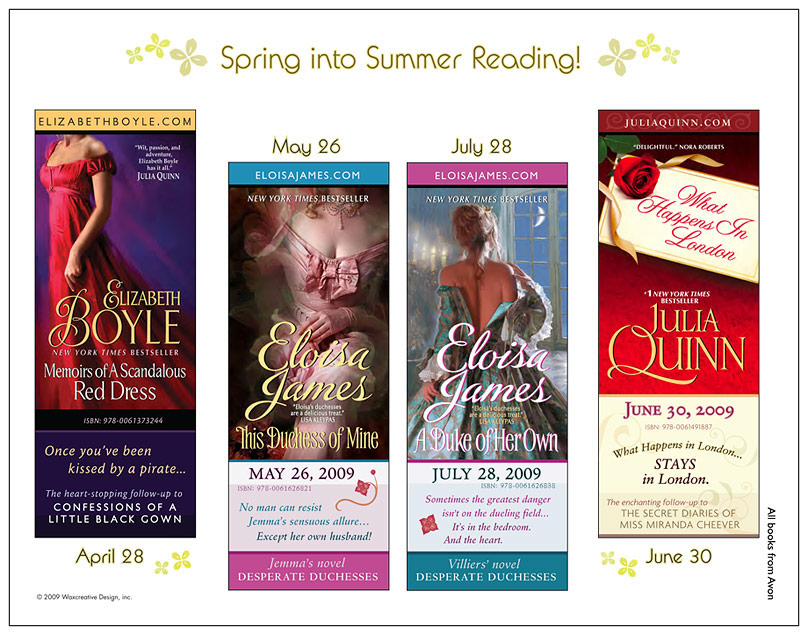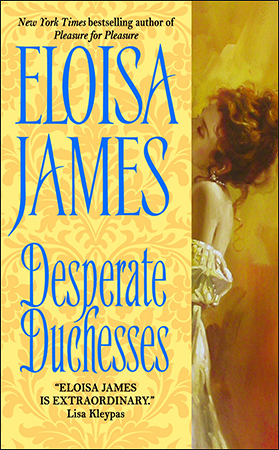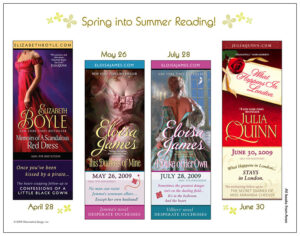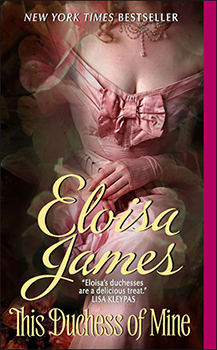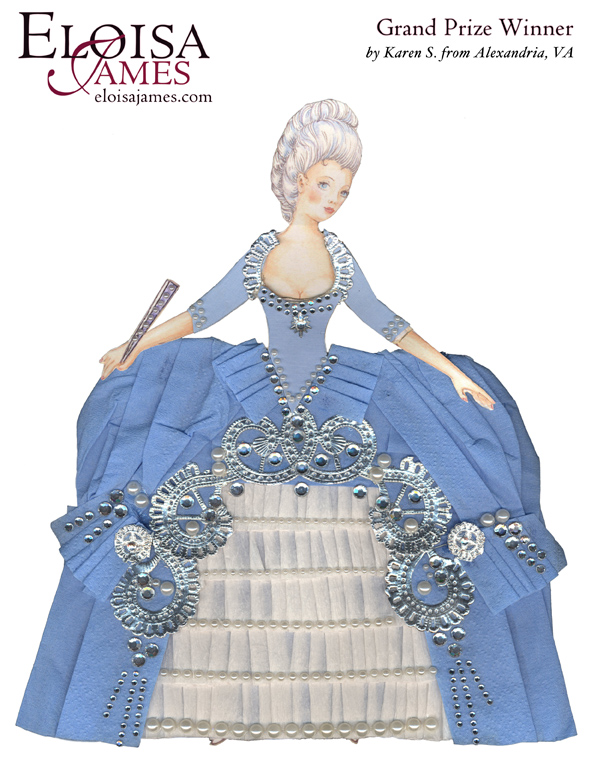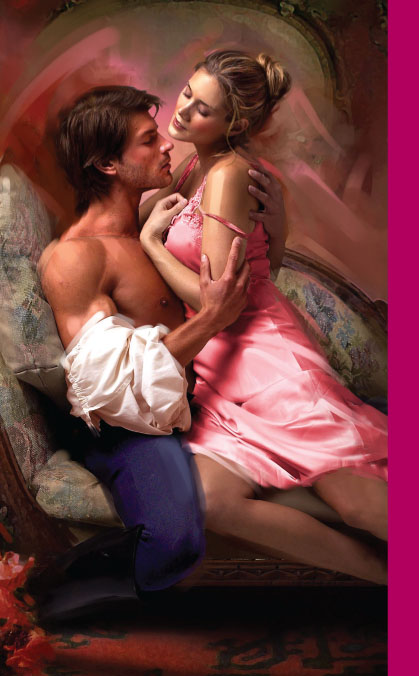
Bookcode: mine
Desperate Duchesses Printable Bookmarks
Enjoy these printable bookmarks featuring This Duchess of Mine and A Duke of Her Own!
Click to see a bigger version that can be printed if you’d like.
Desperate Duchesses (the Original Six) Collectible Card
The covers of each of Eloisa’s series are grouped together into gorgeous collectible cards. In addition to this card for the Desperate Duchesses (the Original Six), there is a card for the Duchess Quartet, Eloisa’s Fairy Tales and the Essex Sisters.
Note: Collectible cards are no longer available.
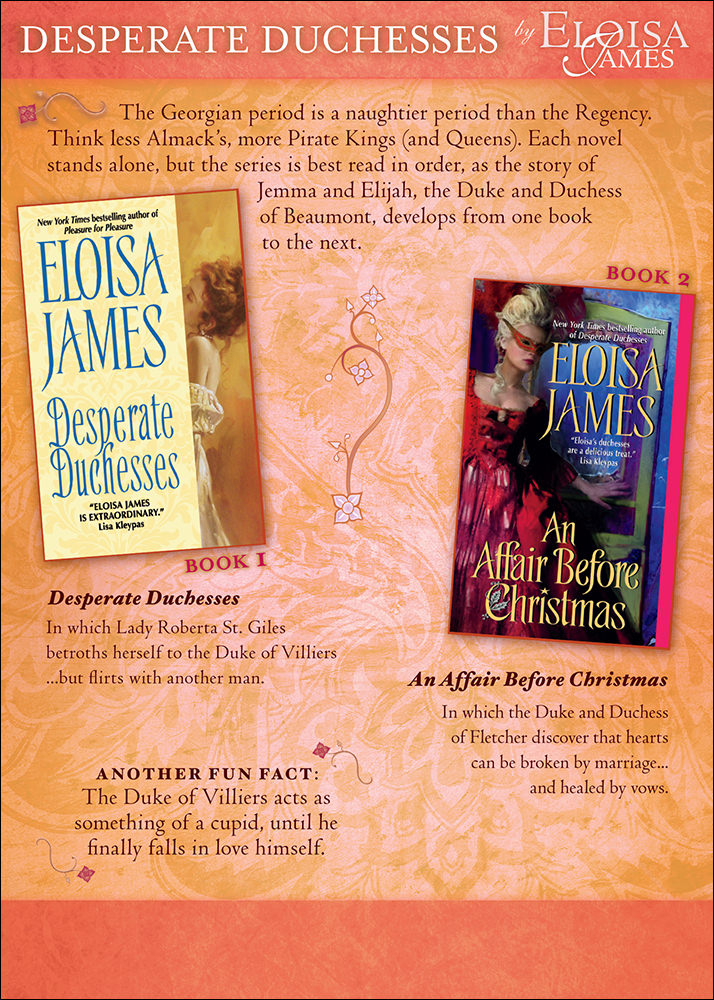
A Multi-Author, Mini-Poster of Bookmarks (Download)
Enjoy these gorgeous downloadable bookmarks featuring titles from Julia Quinn, Laura Lee Guhrke and Elizabeth Boyle! Click to download, cut them out and share them, or leave the pdf whole as a collectors’ item.
Mine: PW bestseller
#12 on the Publishers Weekly bestseller list.
Mine: NYT bestseller
#15 on the New York Times bestseller list.
Inside This Duchess of Mine
- This is the fifth book in the Desperate Duchess series. So, although it stands alone, some characters, such as the Duke of Villiers, appeared first in earlier books. Villiers’s story, A Duke of Her Own, is the sixth book in the series.
- Every book in the Desperate Duchess series opens with the party that closed the previous book. Here’s the party circuit, so far: Desperate Duchesses closed with Jemma’s party to celebrate her brother’s dueling victory; Affair Before Christmas opened at that same party and ended with Jemma’s Twelfth Night masquerade; Duchess by Night opened with the masquerade and ended at Lord Strange’s endless house party; When the Duke Returns began at that house party and ended on the King’s yacht, the Peregrine. This Duchess of Mine opens on the yacht, and ends at a benefit ball given by Jemma. And the opening of A Duke of Her Own? As my son would say, that’s a no-brainer.
- In the first four novels of the Desperate Duchess series, I left one tiny question unanswered. To catch each question, check the Inside Take for the various books. In books five and six, I am answering all of them. The mystery solved here? The question of that very odd chess set, the one that first appeared when Jemma bought the White Queen in Affair Before Christmas, and cropped up again in Duchess by Night… While I won’t tell you for sure if the chess set had magical properties, I think that it’s demise casts an interesting light on the curse it supposedly carries.
- I wish I could tell you that the hulks were my invention or, for that matter, that little boys weren’t being employed as mudlarks. Alas, both abominations existed. Elijah’s house for glassblowers came from my imagination – but again, the terrible physical effects of glassblowing did not.
- This Duchess of Mine opens with Elijah’s terrific race through the streets of a rioting London to reach Jemma. I made up the barricades in Bramble Street, but I was inspired by the marvelous scenes in Terry Pratchett’s NightWatch. The summer I wrote this novel I read through all of Pratchett’s novels, one after another, in total delight. I highly recommend them! If you haven’t tried them, start with Men at Arms; there’s a wonderful little romance between a werewolf and a cop.
- Chess lies at the heart of the plot of this novel. Not only does it detail the last chess game in Jemma and Elijah’s match (blindfolded and in bed!), but I thought of the tangled affections of Jemma, Elijah, and Villiers as a chess game, as he himself points out. Jemma and Elijah are the White royalty; Villiers is the Black King who sacrifices himself, taking the Black Queen off the board.
- And so, finally, Jemma and Elijah play their final chess game. You probably won’t be thinking too much about chess while you read that particular scene. But as I saw it, it had to be a real game. So Professor Lenny Cassuto came to my rescue, as he has in earlier books in the series. If you’d like to follow the chess game he created for Jemma and Elijah, here you go!
Jemma and Elijah’s Final Game – Blindfolded & In Bed
I’m using chess nomenclature here, so P-K4 means that White, which always moves first, takes a pawn to King’s Four. Elijah plays White in this particular game.
1. P-K4 P-K4
2. P-Q4 PxP (first capture)
3. QxP (second capture) N-QB3 (attacking the queen)
4. Q-QR4 (moving the queen out of the way) N-B3 (moving out the other knight)
5. N-KB3 (white develops his knight) B-B4 (she answers by developing her bishop; she’s now ready to castle)
6. B-QN5 (moving out the bishop to attack her knight) P-QR3 (attacking that bishop and asking whether he wants to exchange it for the knight)
7. B-Q3 (he retreats his bishop) 0-0 (castles)
8. N-B3 (developing his other knight) P-Q4 (offering a pawn in exchange for an attack on his king)
9. PxP (he accepts; third capture) R-K1ch (she checks his king and forces it to move)
10. K-B1 N-QN5 (advancing her queen’s knight to attack his bishop)
11. B–KN5 (attacking her knight in front of her king) B-N5 (and she counterattacks his king’s knight)
12. R-Q1 (indirectly defending his extra pawn) P-N4 (attacking his queen, driving it back. She has a strong attack here.)
13. Q-N3 (retreating) P-R3 (“putting the question to the bishop,” as on black’s 6th: will he exchange it for a knight or retreat?)
14. BxN (fourth capture) QxB (fifth capture)
15. P-QR3 (attacking her far-advanced knight to try to drive her pieces back) NxB (exchanging it for his other bishop rather than retreat)
16. RxN (completing the exchange)
And there the game breaks off. In Dr. Cassuto’s analysis: Black (Jemma) is considerably ahead in this position.
1. She has good bishops, and is threatening to break up White’s kingside pawns;
2. White can’t castle, and his rooks aren’t connected. His pieces are tangled up, and his queen is out of play.
3. Black is ready to attack. White has an extra pawn, it’s true, but his position is not enviable, and no good player would be happy with it.
The moves to get to this place have been plausible–not best play, it’s true, but plausible, especially for blindfold play.
A Jemma Paper Doll
Eloisa chose this reader-submitted paper doll for Jemma, her heroine from This Duchess of Mine:
“Jemma would love to wear this gown to Versailles!”
To see six more paper doll dresses designed by readers plus the one Eloisa made, and to access the download template so you can make your own, please explore Eloisa’s Design-a-Duchess Paper Dolls Book Extra.


